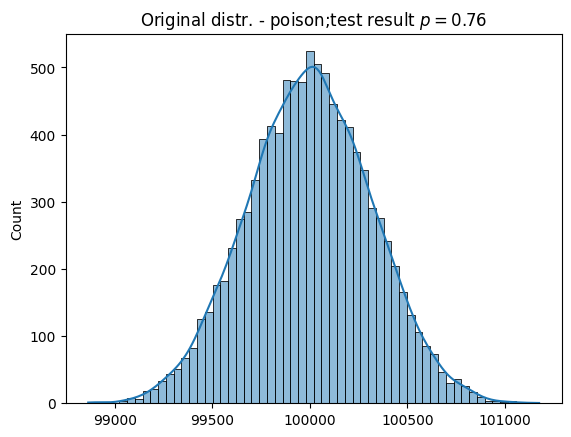Central limit theorem#
Formulation#
Let’s take \(N\) independent values \(x_i\) belonging to the same distribution with mathematical expectation \(\mu\) and standard deviation \(\sigma\).
Let’s denote their sum:
Central limit theorem says that \(S_N \sim N(\mu N; \sigma^2 N)\) (\(S_N\) belongs to normal distibution with parameters \(\mu N, \sigma^2 N\)).
Numerical proof#
Let’s create samples of means of samples from different distributions and explore their characteristics.
We will plot the histogram of the sample of sums and perform the Cramér-von Mises test to understand if \(S_N\) belongs to the normal distribution.
The \(H_0\) of the Cramér-von Mises test in our case is that \(S_N\) is normally distributed, so if \(p>0.05\) we cannot reject this hypothesis.
import numpy as np
import scipy
from scipy.stats import shapiro, anderson
from scipy.stats import cramervonmises
import seaborn as sns
import matplotlib.pyplot as plt
def explore_is_normal(
mu : float, sigma : float,
sample : np.array, orig_distr_name: str
):
"""
Function that returns whether the given sample
belongs to the normal distribution. It plots the
histogram of the distribution and prints the result of the
of the Cramér-von Mises test in the title.
Parameters
----------
mu (float) : mathematical expectation of original random value;
sigma (float) : standart deviation of original random value;
sample (numpy.array) : sample of sums of original samples;
orig_distr_name (str) : name of original distribution
will be pritned on the title of the figure.
Returns
---------
Plotted histogram of exploring sample.
"""
s_len = len(sample)
test_p = cramervonmises(
sample,
cdf=scipy.stats.norm(
mu*s_len,sigma*(s_len**(1/2))
).cdf
).pvalue
sns.histplot(sample, kde=True)
plt.title(
f"Original distr. - {orig_distr_name};"
f" Test result $p={str(round(test_p,2))}$"
)
Normal distribution#
This shows that the sum of the random values sampled from the normal distribution belongs to the normal distribution.
sample = np.random.normal(
2, 3, (10000, 10000)
).sum(axis = 1)
explore(2, 3, sample, "normal")

Poisson distribution#
For this research, it is important that this distribution parameters are \(\mu=\lambda\) and \(\sigma=\sqrt{\lambda}\).
_lambda = 10
sample = np.random.poisson(
_lambda, (10000, 10000)
).sum(axis = 1)
explore(_lambda, _lambda**(1/2), sample, "poison")

